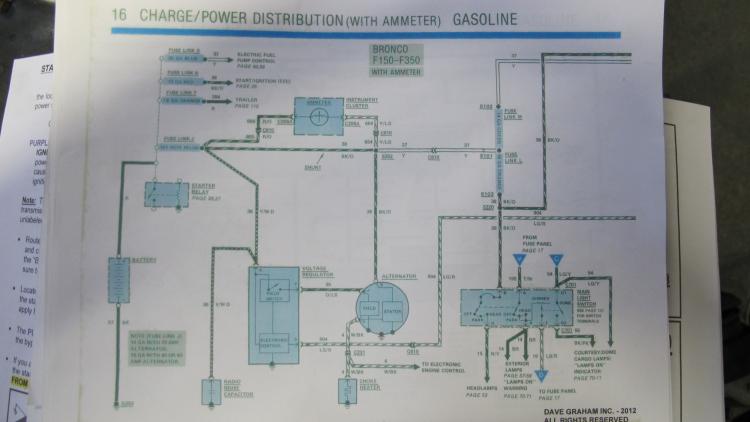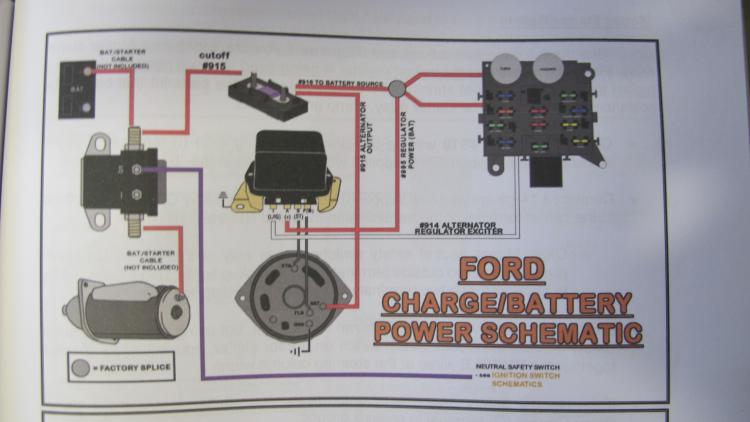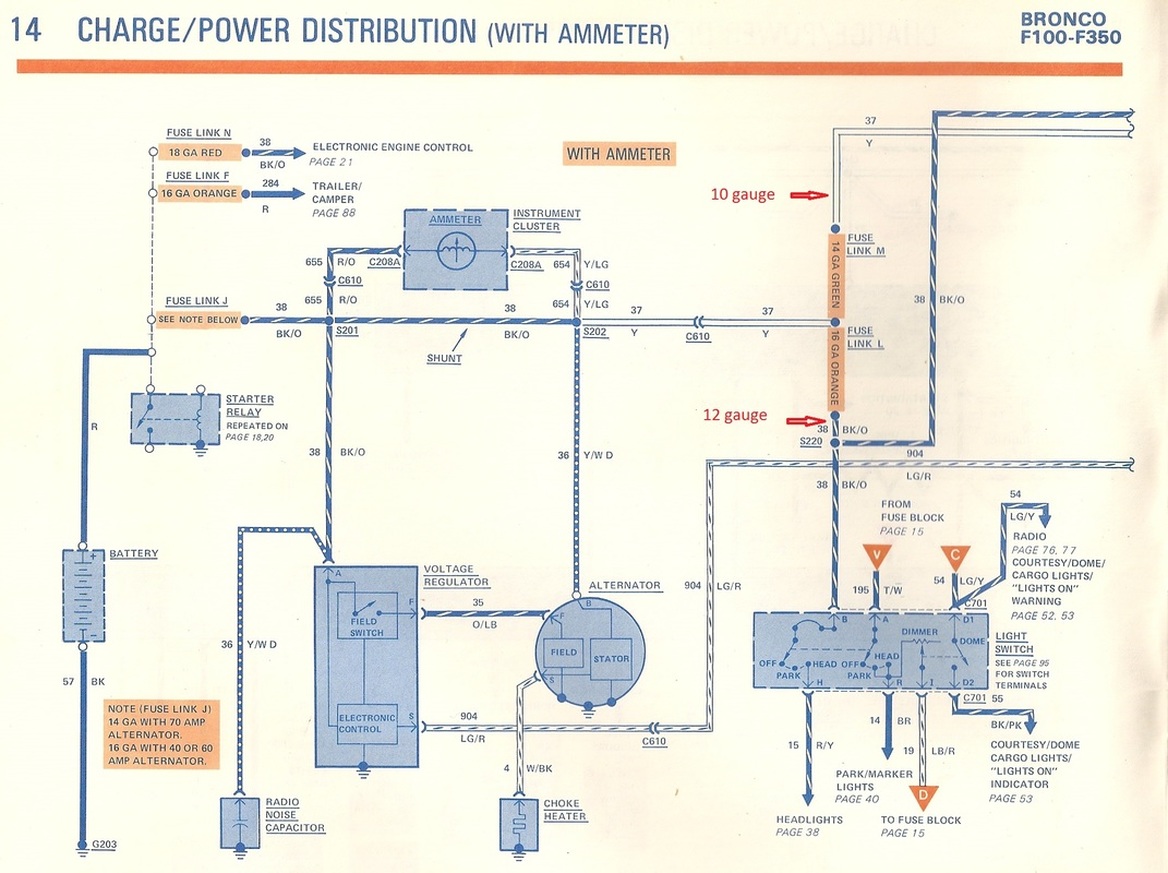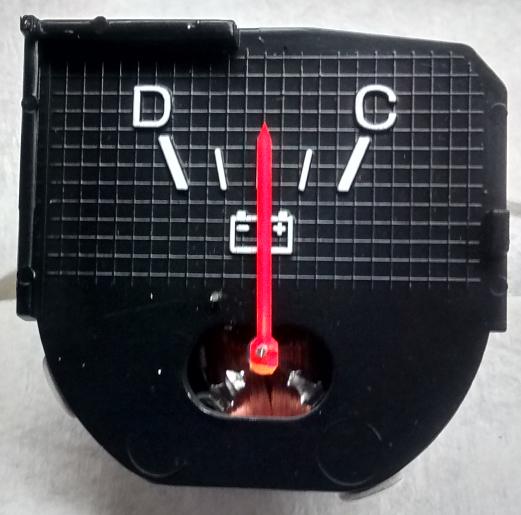Ammeter wiring question
|
Here's the two schematics I'm dealing with, first how the system works in the original harness and second how Painless has it without provisions for an ammeter.
  I could reuse the original alternator wires and connect 37(Y) to #916(bty source) and 38(BK/O) to the MIDI fuse, or skip the fuse since 38 has a fuse link? Or if I use the new wires, can I connect 654(Y/LG) to the MIDI fuse and 655(R/O) to the starter relay? I'm not really sure I understand how the ammeter works, as in if I mess with the length of the wires does that affect it's functionality? I saw another schematic googling this that tied the length of the wires to it's resistance, which made me think I'm fighting a losing battle.
Rob
Eddy Myrtle '84 F150 300-6, Offenhauser C series intake, Edelbrock 1404(500cfm manual choke), EFI exhaust manifold, HEI dizzy, custom Painless harness, NP 435, NP 208, D44, 8.8"/3.08, 1.5" leveling coils, 265/75/16 tires. Toyopet (Daily driver) '86 Toyota Pickup |
|
Administrator
|
Rob - Lots of thoughts. But first, instead of you taking a pic of your EVTM, if you'd look at any of the ones on here, and assuming you are on a computer, you can right click, copy the address of the pic, and then paste it into the Or Copy An Image From The Internet option in Insert Image. It is lots easier than it sounds when I type it out.
And, speaking of that, I did that to put the one in below, which is from the 1981 EVTM, although all of the trucks have the same wiring for the ammeter. Second, are you upgrading to a 3G? If not, you can continue to use the ammeter. But if you are upgrading then the shunt may well melt if you use it the factory way. However, you can use it to only show the draw for things in the cab, as explained on the Ammeter & Voltmeter tab on our page here: Documentation/Electrical/3G Alternator Conversion. Let's stop there and let you answer that question before proceeding. 
Gary, AKA "Gary fellow": Profile
Dad's: '81 F150 Ranger XLT 4x4: Down for restomod: Full-roller "stroked 351M" w/Trick Flow heads & intake, EEC-V SEFI/E4OD/3.50 gears w/Kevlar clutches
|
|
I upgraded to a 95A 3G, and kept the ammeter in the system. I hate things that don't work!
The only change that I made was replacing fuse link J with a 14 gauge like the trucks with 70A alternators had. As long as you don't run the battery low and try to make the alternator recharge it, the alternator will never put out nearly it's rated output. So far, all is good!
Ford Parts Monkey since 1985
1981 F100 Flareside - Black, 302-4V Roller/AOD 1986 F150 Flareside - Medium Fire Red 302/AOD 1989 F150 Standard Cab 4x4 - Dk Shadow Blue 302/AOD 1993 F350 4x4 Crew Cab - 7.3 IDI/ZF-5 I think it's a sickness... |
|
In reply to this post by Gary Lewis
Gary, since I was taking a pic of the Painless diagram I thought I might as well take a pic of the EVTM, but yes an electronic version would no doubt have been more efficient...
I'm sticking with a 60 amp alternator. I have hardly any accessories(blower, radio, lights), so at this time I don't think I need anything more. Don't suppose I need the MIDI fuse either, but is it a good idea too put it in there now? I'm leaning that way. And I would obviously like to go with all the new wires, but I'm willing to go with the old. And yes, my main reason for going through this is the thought of having a gauge that doesn't work is just too much! 
Rob
Eddy Myrtle '84 F150 300-6, Offenhauser C series intake, Edelbrock 1404(500cfm manual choke), EFI exhaust manifold, HEI dizzy, custom Painless harness, NP 435, NP 208, D44, 8.8"/3.08, 1.5" leveling coils, 265/75/16 tires. Toyopet (Daily driver) '86 Toyota Pickup |
|
Administrator
|
I agree, guys. A gauge that doesn't work would drive me bananas! Ok, so the ammeter stays in service.  So let's go back to the questions. You need the shunt, the BK/O #38 between S201 and S202 and 654 & 655 wired exactly as they currently are. (CURRENTLY. Get it.  ) So that would suggest you should connect the BK/O #38 that's connected to Fuse Link J in the diagram I posted to the new fuse. ) So that would suggest you should connect the BK/O #38 that's connected to Fuse Link J in the diagram I posted to the new fuse.
Does that make sense and answer the question? And Myrl is good to go 'cause he went with a smaller alternator, which is sorta compatible with the maybe 70 amp-capable shunt. But go bigger than a 90 amp alternator and you are playing with fire. (FIRE. Get it?  ) )
Gary, AKA "Gary fellow": Profile
Dad's: '81 F150 Ranger XLT 4x4: Down for restomod: Full-roller "stroked 351M" w/Trick Flow heads & intake, EEC-V SEFI/E4OD/3.50 gears w/Kevlar clutches
|
In a good mood Gary?  OK, 654 & 655 might not currently be the same length as they were... So, keeping the setup 100% as intended is not really possible. Are you saying the wires do need to be the original length or just originate at original positions?
Rob
Eddy Myrtle '84 F150 300-6, Offenhauser C series intake, Edelbrock 1404(500cfm manual choke), EFI exhaust manifold, HEI dizzy, custom Painless harness, NP 435, NP 208, D44, 8.8"/3.08, 1.5" leveling coils, 265/75/16 tires. Toyopet (Daily driver) '86 Toyota Pickup |
|
Administrator
|
Yep, on a roll!
 There's no issue with length of 654 and 655. They carry so little current they might as well be headphone wires. But the length of the shunt, meaning the BK/O between splices 201 and 202, should stay roughly the factory length. That wire is a resistance wire. But, a very, very small resistance. So as current flows across it a voltage is developed in accordance with Ohm's Law: E=IR. That voltage generates the current flowing to the ammeter through 654 and 655. There's a writeup on the page at Documention/Electrical/Ammeter and you can see what little voltage and current it takes to swing them to full scale - something like .125 volts and .8 amps. So, the current across the shunt would have to generate the .125 volt drop, and at 70 amps that means the shunt has a resistance value of about .0018 ohms. And at 70 amps that would generate 8.8 watts. But at 130 amps that would generate 30 watts - and might well melt the insulation and fry the wire.
Gary, AKA "Gary fellow": Profile
Dad's: '81 F150 Ranger XLT 4x4: Down for restomod: Full-roller "stroked 351M" w/Trick Flow heads & intake, EEC-V SEFI/E4OD/3.50 gears w/Kevlar clutches
|
|
Got it. So using the old wires should be easy enough.
And you don't think using the new wires and connecting 654 to the MIDI and 655 to the starter relay/solenoid would work? You'd still have a 'shunt' running from the fuse to the solenoid, it could be the same length.
Rob
Eddy Myrtle '84 F150 300-6, Offenhauser C series intake, Edelbrock 1404(500cfm manual choke), EFI exhaust manifold, HEI dizzy, custom Painless harness, NP 435, NP 208, D44, 8.8"/3.08, 1.5" leveling coils, 265/75/16 tires. Toyopet (Daily driver) '86 Toyota Pickup |
|
Administrator
|
If you use EXACTLY the wire that is currently between S201 and S202 then yes it will work. But you cannot use any other wire. It has to be that wire that is between those two splices. It is a special piece of wire.
Gary, AKA "Gary fellow": Profile
Dad's: '81 F150 Ranger XLT 4x4: Down for restomod: Full-roller "stroked 351M" w/Trick Flow heads & intake, EEC-V SEFI/E4OD/3.50 gears w/Kevlar clutches
|
|
OK, I'll have to do some checking to see if I that's possible, as in location of the MIDI v solenoid etc. Using the old wires might be easier.
If I were to go the 'new' route and use the original shunt between the MIDI and solenoid would I be OK to cut it on the inside of the factory splices? I ask since you call it a 'special' wire, I assume it's still just a copper strand core? But it was designed(length and gauge) with the ammeter in mind? And it provides charge to the battery, correct? Or power to the fuse block when not running. Thanks for taking the time walking me through this Gary.
Rob
Eddy Myrtle '84 F150 300-6, Offenhauser C series intake, Edelbrock 1404(500cfm manual choke), EFI exhaust manifold, HEI dizzy, custom Painless harness, NP 435, NP 208, D44, 8.8"/3.08, 1.5" leveling coils, 265/75/16 tires. Toyopet (Daily driver) '86 Toyota Pickup |
|
Administrator
|
I think you'll be fine cutting inside of the splices, but save as much of that wire as is possible. The shorter you make the shunt the less sensitive the ammeter will be. But, they aren't accurate anyway, so....
I think that wire is just a know resistance per inch or foot, so they use it in that position. So, "special" may be a stretch. But maybe "specific"? Happy to help. 
Gary, AKA "Gary fellow": Profile
Dad's: '81 F150 Ranger XLT 4x4: Down for restomod: Full-roller "stroked 351M" w/Trick Flow heads & intake, EEC-V SEFI/E4OD/3.50 gears w/Kevlar clutches
|
|
OK, I'm pretty sure I've got it. And yes, I'll probably add a voltmeter as well for an actual idea of what's going on. As we said, I just hate the idea of seeing a gauge and knowing it doesn't work... Thanks again.
Rob
Eddy Myrtle '84 F150 300-6, Offenhauser C series intake, Edelbrock 1404(500cfm manual choke), EFI exhaust manifold, HEI dizzy, custom Painless harness, NP 435, NP 208, D44, 8.8"/3.08, 1.5" leveling coils, 265/75/16 tires. Toyopet (Daily driver) '86 Toyota Pickup |
|
Administrator
|
But you're making the assumption that the ammeter "actually works"!
...and that's a bit of a stretch. They barely give indication of anything. Consider the Rocketman voltmeter conversion. They look NOS and actually tell you something about the state of charge (or charging)
Jim,
Lil'Red is a '87 F250 HD, 4.10's, 1356 4x4, Zf-5, 3G, PMGR, Saginaw PS, desmogged with a Holley 80508 and Performer intake. Too much other stuff to mention. |
|
Good point Jim, I have two I can test though. I've read there is a test - engine not running, headlights on should show a slight movement towards discharge... If I have one that works I'd rather have that as I'm not that enamored with the idea of a gauge showing something different than what it says. As I said, I'll probably get an aftermarket voltmeter. I have one in my Toyota, a little USB charging port with a voltmeter.
Saying all that, I might still send the 2nd ammeter off at some point when I don't have something better to spend $45 on. And of course if neither works, I'll go that route immediately.
Rob
Eddy Myrtle '84 F150 300-6, Offenhauser C series intake, Edelbrock 1404(500cfm manual choke), EFI exhaust manifold, HEI dizzy, custom Painless harness, NP 435, NP 208, D44, 8.8"/3.08, 1.5" leveling coils, 265/75/16 tires. Toyopet (Daily driver) '86 Toyota Pickup |
|
Administrator
|
It doesn't say 'Amps' just Draining or Charging.
 The way these are set anything left of center is showing you that the alternator is not providing enough to charge the battery.
Jim,
Lil'Red is a '87 F250 HD, 4.10's, 1356 4x4, Zf-5, 3G, PMGR, Saginaw PS, desmogged with a Holley 80508 and Performer intake. Too much other stuff to mention. |
 Another good point Jim, so it's not disingenuous as a voltmeter, but numbers would be more transparent as to it's function. Another good point Jim, so it's not disingenuous as a voltmeter, but numbers would be more transparent as to it's function.
Rob
Eddy Myrtle '84 F150 300-6, Offenhauser C series intake, Edelbrock 1404(500cfm manual choke), EFI exhaust manifold, HEI dizzy, custom Painless harness, NP 435, NP 208, D44, 8.8"/3.08, 1.5" leveling coils, 265/75/16 tires. Toyopet (Daily driver) '86 Toyota Pickup |
| Edit this page |

